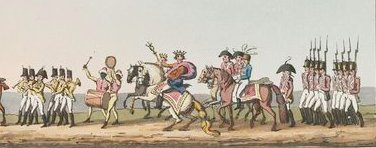The brief but startling report below appeared in the Kentish Weekly Post or Canterbury Journal for Friday 3 February 1804, appended to reports of storms and so forth from the paper’s correspondent in Frant, near Tunbridge Wells, clearly an enthusiast for italics. It re-appeared in a number of papers for that month – the Chester Courant, the Lancaster Gazette, the Staffordshire Advertiser and probably others, since column-filling copy was freely filched in those days, and soon went viral (or as viral as anything could be in 1804), arriving by April almost word for word in The Balance and Columbian Repository of Hudson, New York, and no doubt elsewhere.
INFERNAL MACHINE
A very ingenious young man of the name of Smart, a journeymen taylor in this parish, has invented an infernal machine, which, when placed in any point of contact against an invading force, is capable of destroying a thousand men in a minute. The expence, I am told, will be small when compared with its utility. He leaves this [place] on Monday morning to explain to the Duke of Richmond, the Lord Lieutenant of the County, of[sic] the model of his machine, &c.; it has met the general approbation of all the Gentlemen Volunteer Officers in that neighbourhood; the inventor is a volunteer himself, though a tailor. Should it meet the approbation of the Duke of Richmond, Smart will undertake to conduct it himself into the center of the enemy’s legions; the great merit in the construction of this machine is, that he can remain in perfect safety in the center, while he deals death and destruction to all around him, and he is capable of re-charging in ten minutes; and it can be moved with one horse, with the greatest facility, at the rate of eight miles an hour.
In the British Library copy of this paper the original owner, a compulsive annotator, has noted beneath in wobbly copperplate: “Remark the above”, as well he might.
- Leonardo
- Sadler
So far, I’ve been unable to discover the Duke’s reaction, on which the papers seem silent. Not very enthusiastic, one suspects. Nor does there seem to be any image of Smart’s model of his invention, but the description may give some clues. “Any point of contact” suggests something circular, on a turret principle, while “a thousand men in a minute” surely implies a primitive machine gun; note that “re-charging” would take a full ten minutes. And for the operator to “remain in perfect safety in the centre” must have required some sort of protective plating. What comes to mind is a one-man, horse-drawn version of Leonardo’s celebrated armoured vehicle of 1487, or maybe a covered version of James Sadler’s “moving battery”, or “curricle flying artillery” discussed in this post. (Though Sadler’s vehicle required one man to load and one to fire, plus a driver.) I’m left wondering how Smart’s machine would have gone on if and when the horse was shot, which seems the obvious weakness.
If we know no more about the infernal machine itself, we know quite a lot about its inventor, although, beyond his time in the Pevensey Legion, this seems to have been his single military moment. The Tunbridge Wells tailor George Smart (1775-1846) has become something of a rediscovered hero of English folk art, on account of his quirky cloth collage portraits, sold from his cottage, branded as “Smart’s Repository”. An 1830 view of Frant, with the tiny figure of Smart outside the Repository (right of the carriage) seems to be the only image we have of him. The “artist in cloth and velvet figures” was a tireless self-publicist, often in verse:
Come here, I say, come here ye quizzers,
Who laugh at Taylors and at scissors,
And see how Smart makes that utensil
Out-do the Chisel, Brush and Pencil.
With Genius Quick, and true to nature,
He makes a suit for every creature;
And fits alike the whole creations,
In newest style the latest Fashion …
And so on. In his later years, Smart cultivated a conspicuously eccentric character, but his notoriety and affluence faded, and on his death in 1846 he was given a pauper’s burial. A useful outline of his life and career by James Gregory is available here, and a full length study by Hector Medora, focused mainly on the folk art, is downloadable here. A Smart blog, promoting the art book by Jonathan Christie, is here.
Finally, my favourite Smart collage, a version of his Earth Stopper. The effect of the “apparition” on the gent on horseback must be akin to that anticipated by Smart of the appearance of his infernal machine among the enemy legions.

































![A Duke of Cumberland's Sharpshooter [National Army Museum]](https://thisreilluminatedschoolofmars.files.wordpress.com/2015/06/cumberlands.jpg?w=183&h=300)




